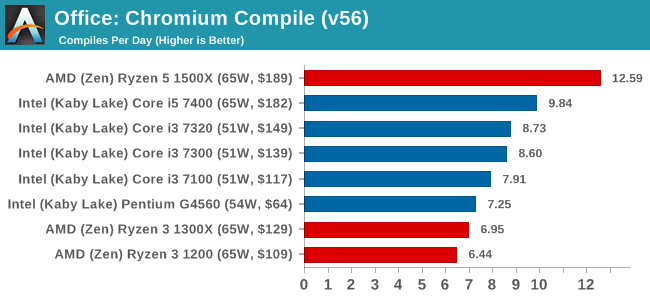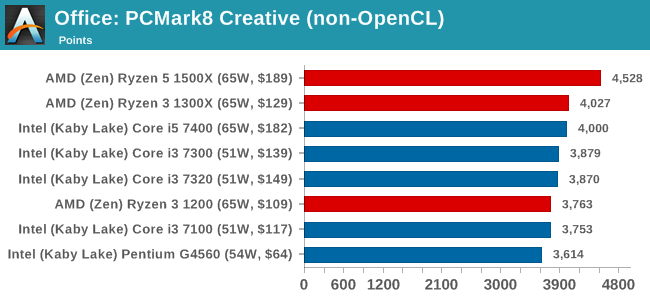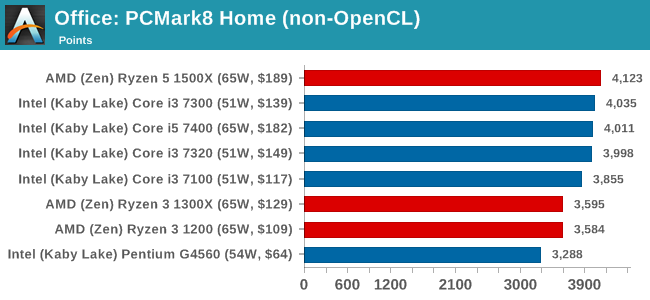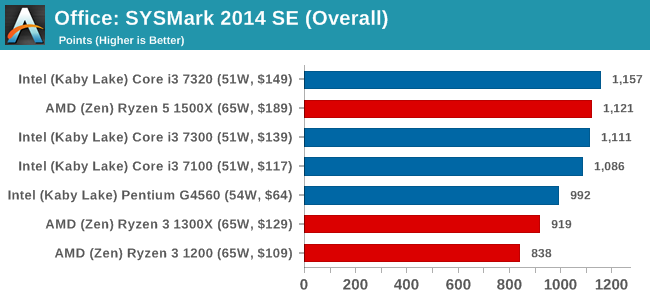The AMD Ryzen 3 1300X and Ryzen 3 1200 CPU Review: Zen on a Budget
by Ian Cutress on July 27, 2017 9:30 AM EST- Posted in
- CPUs
- AMD
- Zen
- Ryzen
- Ryzen 3
- Ryzen 3 1300X
- Ryzen 3 1200
Benchmarking Performance: CPU Office Tests
The office programs we use for benchmarking aren't specific programs per-se, but industry standard tests that hold weight with professionals. The goal of these tests is to use an array of software and techniques that a typical office user might encounter, such as video conferencing, document editing, architectural modeling, and so on and so forth.
All of our benchmark results can also be found in our benchmark engine, Bench.
Chromium Compile (v56)
Our new compilation test uses Windows 10 Pro, VS Community 2015.3 with the Win10 SDK to compile a nightly build of Chromium. We've fixed the test for a build in late March 2017, and we run a fresh full compile in our test. Compilation is the typical example given of a variable threaded workload - some of the compile and linking is linear, whereas other parts are multithreaded.

PCMark8: link
Despite originally coming out in 2008/2009, Futuremark has maintained PCMark8 to remain relevant in 2017. On the scale of complicated tasks, PCMark focuses more on the low-to-mid range of professional workloads, making it a good indicator for what people consider 'office' work. We run the benchmark from the commandline in 'conventional' mode, meaning C++ over OpenCL, to remove the graphics card from the equation and focus purely on the CPU. PCMark8 offers Home, Work and Creative workloads, with some software tests shared and others unique to each benchmark set.



SYSmark 2014 SE: link
SYSmark is developed by Bapco, a consortium of industry CPU companies. The goal of SYSmark is to take stripped down versions of popular software, such as Photoshop and Onenote, and measure how long it takes to process certain tasks within that software. The end result is a score for each of the three segments (Office, Media, Data) as well as an overall score. Here a reference system (Core i3-6100, 4GB DDR3, 256GB SSD, Integrated HD 530 graphics) is used to provide a baseline score of 1000 in each test.
A note on context for these numbers. AMD left Bapco in the last two years, due to differences of opinion on how the benchmarking suites were chosen and AMD believed the tests are angled towards Intel processors and had optimizations to show bigger differences than what AMD felt was present. The following benchmarks are provided as data, but the conflict of opinion between the two companies on the validity of the benchmark is provided as context for the following numbers.











140 Comments
View All Comments
Ian Cutress - Thursday, July 27, 2017 - link
AMD doesn't use the R3 / R5 / R7 nomenclature - that's for graphics.Gothmoth - Thursday, July 27, 2017 - link
i don´t care about gaming or heating my house with a cpu..... so ryzen makes more sense for me. :)x299 was such a disappointment.
MrCommunistGen - Thursday, July 27, 2017 - link
Ian, first off, thanks for the benchmark numbers! I look forward to seeing the rest once they are completed.As far as data is concerned, is there a chance that the DigiCortex results have the wrong numbers next to a couple CPUs?
I'm specifically looking at the i3 7100 being the fastest Intel CPU at 0.63, compared to the rest of the offerings clustering together at 0.37-0.38. To me it looks like the 0.63 should be the i5 7400 and the 7100 should be with the other dual cores.
On another note, it looks like the RoTR Geothermal Valley scene really HATES AMD's HyperThreading - at least on Nvidia hardware/drivers. At first I thought there might be another set of numbers transposed somewhere since the Ryzen 3 CPUs perform SO MUCH better than the 1500X. But I looked back at the 1600X review and the numbers seem consistent -- bad performance on HyperThreaded AMD on a GTX 1080. Prophet's Tomb seems to behave better. Just shows how much architecture and software optimizations for said architecture can either oppose or compliment each other.
As for small typos, there's also a couple spots where the 1200 is referred to as "1200X". There was another one I found during my initial read that I can't find now that I'm commenting.
MrCommunistGen - Thursday, July 27, 2017 - link
Not the typo I was looking for, but I just noticed that the intro/description for Civ6 looks like it has a typo I've missed in previous articles:"...but every edition from the second to the sixth, including the fifth as voiced by the late Leonard Nimoy, it a game that is easy to pick up, but hard to master."
"it a game" should probably be "is a game"
Not a criticism, just trying to help out where I can. :)
MrCommunistGen - Thursday, July 27, 2017 - link
Gah... brain fart this morning. Please read my references to AMD "HyperThreading" as "SMT"... smhIan Cutress - Thursday, July 27, 2017 - link
i3 7100 should be 0.363x on DigiCortex. I've corrected three 7100 results today in our database from my personal master copy. I think I'll have to go through them all and double check.RoTR Geothermal on 1080p with a GTX 1080 really loves quad cores without hyperthreading, AMD or Intel. I'm not sure what it is with that test on that benchmark - in our KBL-X review, all the i5s got top results by a good margin. I think it's been optimized specifically for quad-core, or there's something iffy in the game code/drivers.
Appreciate the typo point outs for sure. These things are always last minute and you can never have too many eyes on it. :)
DanGer1 - Thursday, July 27, 2017 - link
The review is lacking, especially the value charts. Ryzens come with a cooler, their motherboards cost less and they are overclock-able. Adjusting the cost for the motherboard and the cooler changes the value charts significantly in R3's favor. Overclocking on stock air makes makes performance and value a no contest in favor of the R3s.MajGenRelativity - Thursday, July 27, 2017 - link
Intel's processors also come with a cooler.wallysb01 - Thursday, July 27, 2017 - link
Basic 1511 boards that would go into i3/Pentium builds are really not much more, if at all, than the lower end AM4 boards. Plus, the Intel stuff has an iGPU and if you're buying a low end desktop, you probably don't care a lot about heavily multithreaded workloads. So, I'd actually argue the i3/Pentiums are getting under sold in the value charts.Its kinda funny how the landscape has switched, in that Intel might actually be the better low-end, value winner, while AMD is the best mid/mid-high end value winner.
Gothmoth - Thursday, July 27, 2017 - link
+1 for overclocking.the tested intel cpus are sure not k models.
as for intel having internal GPU.. i never used them not even on my cheapest system builds.